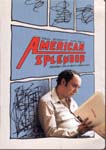

AMERICAN SPLENDOR
Montage:
1. metric montage: length of shots are equal.
2. rhythmic montage: based on rhythm of movement in the shot
3. tonal montage: emotional tone
4. overtonal montage: combination of firth three
5. intellectual montage: juxtaposition for intellectual affect.
American Splendor
The comic books known as American Splendor were written by Harvey Pekar and basically deal with his daily life. The comic is almost a kind of diary which concerns itself with things which he thinks about on a day to day basis.
How does the film reflect its graphic origins? What kinds of questions does it raise?
After the film
The film slides back and forth between representation and reality. Pekar notes early that in different issues drawn by different people he looks different. His fiancée also comments about this in the story. He muses over what he will look like in the film itself. At times the real Harvey Pekar is in the film and at other times Paul Giametti appears as Harvey. In addition, Harvey is played on stage by Donald Logue.
Similarly Toby Radloff appears as himself, but the character is also played by Judah Friedlander.
Joyce Brabner is played at times by Hope Davis, but also appears as herself
David Letterman appears only as himself and then only on TV with the real Harvey.
What does this do to the question of the interaction between reality/comics/and film?
Opening
set like cartoon
Film in 2 distinct parts: documentary (with real Harvey) = shot in HD video (rest in 35)
Captions appear = looks like panels. –some are actual photos some are drawings.
Mr. Nods short and round as drawn by Crum
capture same tone
marriage = high drama or deadpan
Recognition that he is going no where – all visual.
thought balloon rather than voice over
animation in the background of Harvey at supermarket
sound of slide show
split scream lke Rock Hudson and Doris Day
brass flower = he is left with it when wife leaves, second wife picks it up
Change in film after cancer episode seems somewhat grainier. Harvey's world changes after his battle with cancer.
The film deals with Harvey's negativity about everything and always seeing the worst. He is concerned about dying and not having made a "mark" in the world. His last monologue about who and what is a Harvey Pekar and the names in the phone book indicate some of this involvement. The fact that some of them appear to be father and son and Harvey has no children is also significant here. He has a dead end job and won't even have children. Hence the adotion of the child begins a kind of legacy - the child wants to write comics too - but about her.